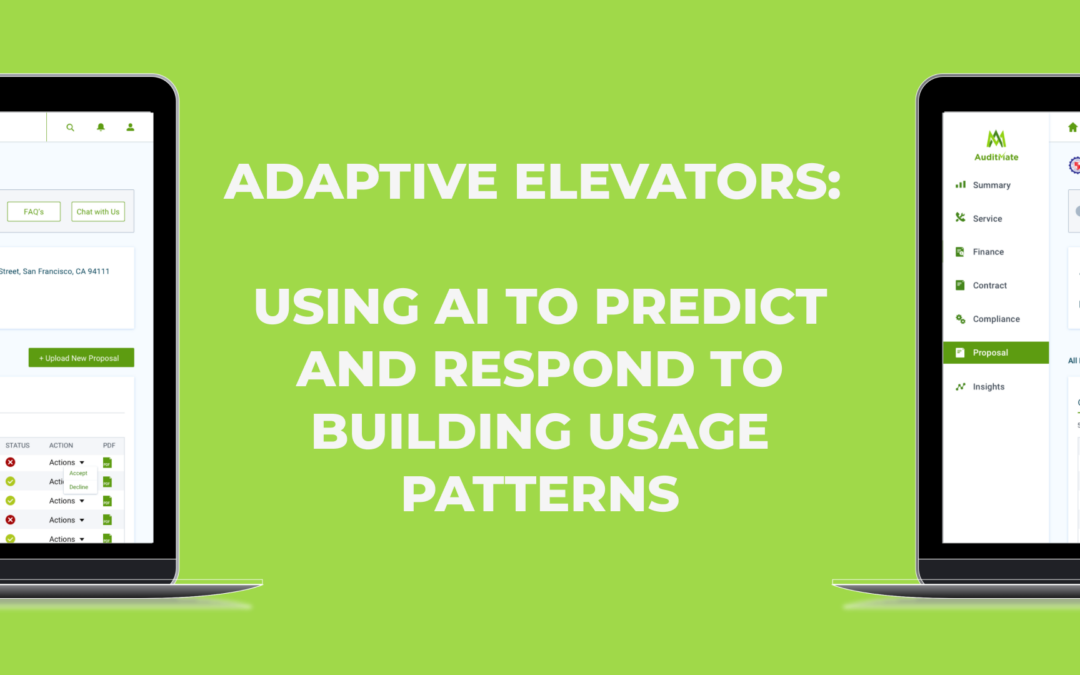Waiting for elevators can be frustrating, especially during rush hours. Here’s an interesting fact: Adaptive elevators use AI to predict and respond to how buildings are used. This article will show you how this technology makes elevator rides faster and more efficient. Keep reading to discover smarter ways to move!
Importance of using AI in building engineering
Using AI in building engineering is a game changer for you as a building owner or facility executive. It’s like having a superpower to make your buildings smarter, safer, and more energy-efficient.
Imagine using artificial intelligence and computer vision technology to spot where you can save energy. Or how about reducing risks by keeping an eye on safety around the clock? This isn’t just wishful thinking.

The fusion of AI with IoT technologies has already begun reshaping construction management, predicting energy needs, and monitoring safety.
These advances mean big improvements for how buildings operate. You get to enjoy lower energy bills thanks to smart predictions on power demand. At the same time, ensuring your property is safe becomes less of a headache because you have AI watching over things 24/7.
So, embracing these tech tools puts you ahead in managing your properties efficiently and plays a part in leading the green revolution in building engineering.
Predicting and responding to building usage patterns
Moving from the significance of AI in building engineering, it’s time to explore how adaptive elevators can smartly adjust to daily routines. The Intelligent Elevator Information System (IEIS) taps into AI for predicting and reacting wonderfully to how a building breathes life throughout the day.
Imagine a typical weekday, where this smart system whips up predictions dividing elevator usage into three distinct times: peak periods when everyone seems to be on the move, idle times when silence takes over, and balanced periods that fall nicely in between.
You’ll see your building operating smoother than ever. With occupancy monitoring, IEIS ensures elevators are there when needed while saving energy during those quiet times. It’s all about hitting that sweet spot—keeping operations efficient, cutting down on unnecessary human meddling, and even offering services specifically for the people walking through your doors.
These actions are driven by a savvy deep learning framework which keeps tabs on who’s coming in or out and how busy things get—bringing you closer to an effortlessly managed building environment.
Overview of the article’s major contributions and structure
To make the leap from understanding building usage patterns to applying this knowledge, this article presents major insights into adaptive elevators powered by AI. You’re looking at a comprehensive guide that introduces the Intelligent Elevator Information System (IEIS), developed using cutting-edge computer vision technology.
This system monitors space utilization within buildings and ensures occupants are comfortable while energy use is efficient.
Through a carefully designed pipeline framework, we detail how elevator doors’ states are judged accurately, passengers’ attributes recognized swiftly, and traffic counted without any duplicates.
Your building can now benefit from demand-based operational strategies for those peak periods, achieve balance during idle times, and optimize performance throughout. With deep learning approaches showing high accuracy in every stage of our experiments, you stand on the brink of transforming how your building’s elevators operate – making them smarter, more responsive to tenant needs here and now.
With every floor reached more efficiently, adaptive elevators are redefining urban energy efficiency one ride at a time.
Related Work

People have studied smart elevators before. They looked at how doors work, saw who was walking in, and checked how full it got.
Previous research on intelligent elevators, door status detection, and pedestrian attribute recognition
Experts have been working on smart elevators that know how many people are inside and what floors they are going to. They use cameras and sensors to see if doors open or close and who is walking in or out.
This idea comes from a big project with Shanghai XinChao Media Group Co. They looked into ways for elevators to work better during busy times, quiet times, and normal times.
They also studied faces, bodies, and clothes of people using the elevator. The goal was to make elevators smarter so they could handle more people smoothly without waiting too long.
By understanding who uses the elevator and how it is used, buildings can offer better service to everyone inside.
Gap in the literature
Continuing from the discussion on intelligent elevators and their potential, a significant gap exists in understanding how these systems can truly understand and adapt to the people they serve.
Despite advances, there’s still much room for improvement in recognizing passenger attributes within elevator settings. This area remains underexplored, showing a real need for AI and big data analytics to make building automation smarter.
The heart of the matter lies in limited studies focusing specifically on unusual or abnormal behaviors among passengers—a scenario that presents both a challenge and an opportunity for innovation.
Building owners and facility executives like you are yet to fully benefit from the integration of advanced analytics into building management systems (BAMSs). This oversight limits not just operational efficiency but also user satisfaction—a gap begging to be filled by future research efforts.
Your buildings could become more than structures; they could turn into responsive environments adapting to occupants’ needs.
Dataset and Methods
We gathered a bunch of data for our study, from how many people ride the elevator to when and where they go. Using special computer tricks, we made sure this info was top-notch for figuring out things like which doors were open and who was getting on.
Description of the dataset used
Your project will use the MEPA dataset, which includes 10,000 training sets and 2,909 test sets. This data comes from three residential buildings in Shanghai with different heights: 18, 24, and 32 floors.
Within this dataset, there are seven categories and twenty classes of attributes to help you understand how people move through these buildings.
Besides MEPA, your work can draw on public datasets like PETA and PA-100K for pedestrian recognition. For tracking individuals across different camera views—a task known as pedestrian ReID—you have access to Market-1501, Duke-MTMC, and CUHK03 datasets.
These resources provide rich information about building occupants’ patterns and behaviors essential for optimizing elevator operations using AI.
Data augmentation techniques
After exploring the dataset used for our AI-driven elevator project, it’s clear that data augmentation techniques are crucial. These strategies enhance the size and quality of our dataset, ensuring more accurate and reliable AI performance.
Now, let’s explore the methods we employed:
- Random Erasure Augmentation (REA) played a key role by expanding our dataset to an impressive 15,635 images. This involves randomly selecting parts of an image to erase, forcing the model to focus on various features.
- We also used random cropping as part of our augmentation strategy. This means taking different portions of an image each time, which helps the model learn from a wider variety of angles and details.
- Adding to the diversity, rotation was applied to images. It teaches the model to recognize patterns and details from different orientations, making identification more effective regardless of how data is presented.
4s Image cropping got us closer into specific sections of an image, highlighting important features that might be lost in a wider view. - Through these data enhancement techniques, including increasing dataset size with image manipulation methods like augmentation and enrichment, we significantly improved our system’s learning potential.
Each step taken has been crucial in developing a more intelligent elevator system capable of adapting seamlessly to building usage patterns.
Overview of the models and methods used for door status detection, passenger recognition, and occupancy analysis
Moving on from data augmentation techniques, let’s focus on how these methods apply to your elevator systems. The YOLO model kicks into action for spotting passengers as they approach the elevator.
Imagine cameras seamlessly picking up movement and figures, all thanks to this powerful detection tool. It’s like having an eagle-eyed observer that never blinks.
For deeper insights into who’s boarding the elevator, the MAR-SVGG model steps up. This method isn’t just about seeing; it’s about understanding more – think clothes, bags, even emotions.
Combine this with FT-Resnet for re-identification, ensuring no mix-ups or confusion about passenger journeys in your building. You get a full package: entrance to exit tracking, real-time occupancy levels, and detailed attribute recognition of every passenger.
Harnessing AI in elevators transforms them from mere transport devices to intelligent building management tools.
Experiments and Results
Our tests showed the system works well. We saw clear patterns in how people use elevators and when they use them most.
Validation of the pipeline algorithm
The team put the pipeline algorithm through rigorous tests. They used a deep learning approach, and the results were outstanding. At each of the three stages – door status detection, passenger detection and attribute recognition, then finally passenger flow statistics and occupancy analysis – accuracy was high.
This means you can count on reliable data to inform your elevator operations.
Next up, let’s look at how this plays out in real-world scenarios with elevator occupancy and usage patterns.
Analysis of elevator occupancy and usage patterns
As a building owner or facility executive, keeping abreast of how your space is being used is paramount to efficiency and user satisfaction. Your elevators, the arteries of your building, are no exception. Through the lens of AI, we’ve been able to peek into the future of elevator management, identifying patterns that save time, energy, and frustration.
Time of Day | Occupancy Pattern | Operation Strategy |
Peak Hours (Morning) | High Occupancy | Direct elevators to busiest floors |
Midday | Balance Period | Optimize for energy efficiency |
Peak Hours (Evening) | High Occupancy | Increased elevator availability |
Off Hours | Low Occupancy | Minimal operation, standby mode |
Cutting-edge AI has made it possible to monitor elevator occupancy in real-time without the hassle of tracking the same passengers multiple times. This innovation segments daily operations into peak, idle, and balance periods, allowing for a dynamic response that wasn’t possible before.
Imagine your building, responding in real-time to the flow of human traffic. Your elevators, once a point of congestion, now a model of efficiency. This isn’t a distant possibility but a current reality. By classifying these periods throughout the day, strategic decisions can be made to either conserve energy during idle times or to provide swift service during the rush, all while maintaining a seamless experience for users.
Now, let’s move ahead to explore the potential benefits this technology can offer.
Discussion and Future Research
In the future, we see elevators getting smarter. They’ll plan their own paths and learn from every ride, always aiming to save more energy and cut down wait times.
Suggestions for elevator operation strategies
You need to keep your building’s elevators running smoothly and efficiently. Adaptive elevators use AI to adjust to how people use the building, even changing indoor conditions like temperature based on what passengers prefer.
- Use demand-based operational strategies. This means your elevators can learn from how often and when people use them. Then, they adjust their schedules to be ready right when most needed.
- Introduce adaptive indoor climate control in the elevators. Your passengers will feel more comfortable if the elevator can change its temperature or humidity depending on who’s inside or how many people are there.
- Opt for intelligent elevator systems that keep track of regular usage patterns and peak times. With this data, you can plan better and avoid congestion during busy hours.
- Focus on lift operation tactics that prioritize safety and energy efficiency. This could mean less running time for lifts during slow hours, saving you money on power.
- Apply passenger preference-based adjustments to make rides more enjoyable. If sensors detect a full elevator, they could skip floors with fewer waiting passengers or go straight to higher floors first.
6.Actively manage your elevators by using smart building technologies that give real-time updates about each elevator’s status and performance.
7.Explore passenger-centric elevator designs that offer features like voice recognition for floor selection or interactive screens for news and weather updates while riding.
8.Regularly review elevator management techniques through AI insights to continuously improve service quality and operational efficiency.
9.Investigate efficient elevator operation methods that minimize wait times by predicting demand spikes using historical data and trends.
10.Look into future research directions for elevators to stay ahead of technological advancements and ensure your building remains cutting-edge and user-friendly.
Potential benefits of implementing AI in elevators
Using AI in your building’s elevators brings many great benefits. Your operations become more efficient, needing less human help. Imagine elevators that know the busiest times and plan ahead to move people faster.
This smart approach saves energy and time. Plus, your guests get a better experience. They feel special when the elevator suggests services just for them based on their age or whether they are male or female.
Smart technology in elevators opens up new ways to serve passengers better. For example, in smart hotels, elevators can recommend room types or services that fit each guest best. This makes every visit more personal and enjoyable.
It’s not just about moving from floor to floor; it’s about making each journey inside the building as smooth and customized as possible for everyone who walks through your doors.
Limitations and areas for future research
After exploring the vast benefits of AI in elevators, we come to understand that this journey has its challenges. One major hurdle is extracting useful information from data. With so many different things happening at once – people walking in different ways, some carrying items, others not – getting clear info is hard.
Imagine trying to recognize every person’s face in a crowded room; now think about doing this with machines. It’s tricky because there are many obstacles like shadows or someone standing too close to another.
Then, there’s the issue of making sure our AI understands all types of buildings and their energy use. Right now, we don’t fully grasp how people moving around inside homes affect how much power a building needs.
This gap means we could make even better systems if we knew more about this relationship. So, your role as building owners and facility executives is crucial here – by staying informed and engaged with these evolving technologies, you help pave the way for smarter buildings.
Conclusion
Adaptive elevators equipped with an Intelligent Elevator Information System (IEIS) have the power to change how buildings manage energy, comfort, and access. IEIS aims for your building to use energy wisely while keeping elevators running smoothly.
It makes sure elevators work best during busy times, stay quiet when not needed, and keep a balance so everyone gets great service without waiting too long. This smart system cuts down on unnecessary steps by figuring out how many people are in the building at different times.
That means you can look forward to lower energy bills and happier folks walking through your doors.
This is where AuditMate steps in. Think of it as your behind-the-scenes hero making sure everything runs like clockwork. With AuditMate’s SaaS-based elevator audit software, getting a grip on complex challenges becomes simpler.
It turns data into something you can actually use to make smarter decisions about maintenance and management—ensuring no detail is overlooked and every contract sticks to its word.
Ready for smoother operations and cost savings? Reach out to AuditMate today for support that lifts your elevator management game.
FAQs
1. What are adaptive elevators?
Adaptive elevators, they’re a new kind of technology… They use AI to predict and respond to building usage patterns.
2. How do these AI-driven elevators work?
Well, imagine this – the elevator system uses artificial intelligence to learn from past data. It understands when people usually need an elevator, like during rush hours or lunch breaks… And then it adjusts its operations accordingly!
3. Can adaptive elevators improve efficiency in buildings?
Absolutely! By predicting usage patterns, these smart systems can reduce waiting times and manage energy consumption more effectively… Think about it – fewer frustrated people waiting for lifts and lower energy bills too!
4. Are there any challenges with implementing such a system?
Sure thing! While the benefits are clear, integrating AI into existing infrastructure could be complex… But hey, that’s where expert help comes in handy!

